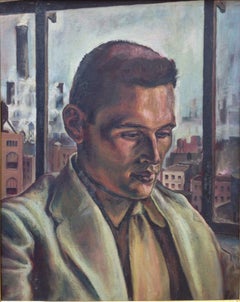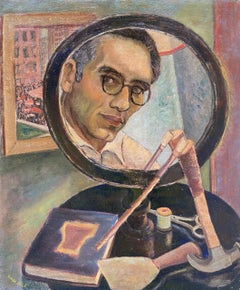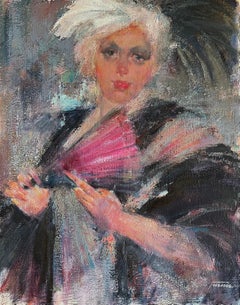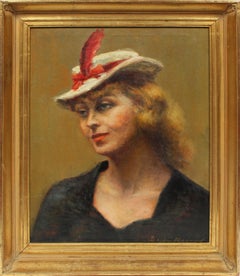Joseph Biel Art
to
1
2
Overall Width
to
Overall Height
to
2
2
2
2
2
2
1
2
2
1
1
1
2
7,820
5,167
2,504
1,501
2
1
1
Artist: Joseph Biel
"Portrait of Dr. Monroe Mufson"
By Joseph Biel
Located in Southampton, NY
Unsigned ; attributed to Joseph Biel
Good friend of Dr. Mufson
View is from New York University School
of Medicine.
Overall size with original frame 25.5 x 21 in.
Category
Mid-20th Century American Modern Joseph Biel Art
Materials
Oil, Board
Self Portrait in a Mirror with Artist's Tools, Oil on canvas, Signed, Polish
By Joseph Biel
Located in London, GB
Oil on canvas, signed bottom left
Image size: 24 x 20 inches (61 x 51 cm)
Contemporary style hand made frame
Joseph Biel
Joseph Biel was a painter and photographer who was born in ...
Category
20th Century Modern Joseph Biel Art
Materials
Canvas, Oil
Related Items
LADY WITH PICK FAN
Located in Los Angeles, CA
Biography from the niece of the artist from during his lifetime. Paintings acquired from the artist.s estate.
Max Turner
1925 - 2019
Max Lamar Turner Painter, Sculptor, Teacher and Author.
Max Turner was born in Omaha, Nebraska on July 28, 1925. His father was Lance Howard Turner and his mother Mary Irene Turner. In 1927, his family moved to Bingham Canyon, Utah where Max's father extracted copper from a creek that he had diverted to pass through his garage. The town was located in a narrow canyon on the eastern face of the Oquirrh Mountains. In 1938, when Max was 13, his family moved to Midvale, Utah. After completing high school, Max went to work laying rail until he was inducted into the U.S. Navy to serve during W.W. II.
There he took an aptitude test and was initially assigned to the medical corp., later transferring to the dental unit. Max was stationed at Port Hueneme, Ventura County, California through the end of the war. When he was discharged in 1946, he remained in Southern California, living in the Los Angeles area. He met a man named Larry Torres and they formed a partnership to do silk screen work primarily for the Colby Poster Printing Company. This lasted about 10 years until the Colby building caught fire and burned down. In 1958, Max began working for Slade Novelty company that made doll parts using a product called plastisol. A year later, Max began producing plastic parts through his own business. One day, a couple of kids brought in a shrunken skull they had made and asked Max if he could reproduce it. Max said he could and he looked around for a business to work with for this task. He ultimately decided he could create his own machine shop to make molds. As a result, Max purchased a lathe, drill press, grinder and other tools to create his own machine shop and went into business making molds. He built a clientele and in 1973, he moved his machine shop to Glendale, California.
Painter, Sculptor, Teacher and Author:
Max recalls the day when his interest in art took a new direction. He happened to be in a paint store to purchase some supplies when he saw a card posted on a wall that read, "Come paint with Connie Marlo". Max had been interested in art since his youth and he was frequently impressed with paintings displayed by local artists at various community events.
Consequently, he decided to go to Connie's Saturday morning art class at a studio on North La Brea Avenue (between Sunset and Hollywood) in Los Angeles. But, as fate would have it, he immediately took a detour from this class when he found a piece of paper on the floor of the studio referencing another art class dealing with compositions, patterns, rhythms and color harmony. The instructor's name was Hal Reed, a former art student of the Russian/American Master, Nicolai Fechin. Hal owned the building (previously the Will Foster Studio) and had founded the Art League of Los Angeles. When Max found Hal, he asked Hal if he could join his class. Hal said "No, the class was full" but he said Max could monitor the class in the back of the classroom. Max took him up on the offer and began observing the weekly class.
During the class, Hal told his students that they should practice what they were learning by going to "live model" classes. Max began attending these classes where he learned how to draw figures. After a few months, Hal and Max became good friends. Hal was so impressed with Max's work that he offered Max the opportunity to teach at another location that Hal was opening in the San Fernando Valley. Max accepted the offer and began teaching his own art class. For Max, it was a quick jump from learning to teaching. Max then found that several of his students had to commute to his art class from the west end of the "Valley". To better serve this group of students, Max decided to relocate to another studio in Calabasas.
Max continued teaching, and at this time he was producing very impressive portraits, both oil paintings and charcoal drawings from live models (Max never worked from photos). Max demonstrated real talent, and the style of his drawings and paintings were being compared to those of Nicolai Fechin. And, like Fechin, Max also had an interest in sculpting. One day, Max decided to design and cast a bronze owl sculpture to put in his Calabasas Fine Art Gallery. Later, someone approached Max when he was at the foundry and asked him about his success selling the owl sculpture. The individual who asked this question was convinced that there was a broader market for these sculptures and he ordered a dozen of the owl sculptures from Max. This encouraged Max to do more castings. Some of the new castings were antique sculptures he found and reproduced. As this new business grew, he decided to establish his own foundry, employing up to 15 workers. The business continued for many years, up until the late 1990's when Max got tired of the foundry business and sold it.
Max, who was now in his 70's, decided to move on to his next venture as an artist, dedicating himself to doing the actual sculpting of original art. He loved the creativity of sculpting and he had his sculptures cast at local foundries, ironically the same ones that used to be his competition. Max was now fully engaged in his new artistic direction and, over time, he produced a large body of work. He created very impressive sculptures, including about 100 full-size sculptures. He sold some of these to high-end clientele, the Foundry at SLS Las Vegas, and to Hollywood studios.
Even though Max now seemed to be totally in his element, he somehow also found time to continue to teach painting classes at the California Art Institute in Westlake Village in Los Angeles. At the institute, he specialized in figure work. Max continued to draw, paint and teach, but he says he stopped sculpting when he turned 90.
Max produced four books showcasing his drawings and paintings. The first is "Faces, The Drawings of Max Turner", copyright 2000, that showcases nearly 100 of his portrait drawings. Within the "Acknowledgements" section, he lists Hal Reed and Joseph Nordmann, two former students of Nicolai Fechin.
In 2006, Max produced his second book titled "Figures and Faces", reflecting not only portraits but also figure drawings and paintings. It is a wonderful book of Max's work, but it is currently difficult to find. The third book is titled "Faces 2, The Paintings and Drawings of Max Turner", copyright 2009, which includes 75 portrait paintings and drawings. In the "Preface" of this book, Max describes growing up in a small and isolated mining town during the Great Depression. He states that as a kid, he had little exposure of any culture or view of what the rest of the world was like. His neighbor was the trash collector and Max would sometimes go through his truck looking for anything of value. Among other things, he found magazines like Cosmopolitan, Good Housekeeping and Red Book, with covers that frequently showed drawings or paintings of faces. Max states that these images were the very first source of inspiration for him. He says that he began looking more carefully at people's faces and if they had character, he would draw them. By drawing them, Max says that he was making them part of his world, his world of "Faces".
In 2018, Max published his newest book showcasing his drawings and paintings. It is titled "Max Turner's Figure Sketches". This softbound book includes 76 pages and over 120 drawings and paintings. In the Introduction, Max explains "I have found that when approaching the figure, one should begin with the gesture. After having captured the essence or feeling of the pose, one can then proceed to build on it." The figure sketches in this wonderful book reflect a Master's work that consistently captures the "gesture"-showing the emotion, movement and expression.
Two more books are on the horizon for Max, both dealing with his passion for sculpting. His first, "The Sculpture of Max Turner" is a compilation of his commercial and noncommercial pieces throughout his career. The second, "Terra Cotta Sculpture by Max Turner" is a complete collection of figures done at the California Art Institute. These much anticipated books should be out later in 2018.
Max now considers himself primarily a sculptor. But others in the art world are more than impressed with his drawings and paintings as well. His portraits are often described as having a Fechin-esque appearance, referring to the style of Nicolai Fechin. When Max observed those first art classes given by Hal Reed, it should be noted that Hal had previously been a student of the Russian/American Master Nicolai Fechin in the early to mid-1950's. In fact, Hal was a student in the last art class that Fechin taught before he unexpectedly died in 1955. Hal was so strongly influenced by Fechin that he later produced two 30-minute art instruction videos as part his Art Video Productions wherein he specifically described Fechin techniques that he learned in Fechin's class. The Fechin style and techniques were in play when Max later met Hal. Over the years, many of Max's art students, art collectors, gallery owners, as well as the Director of the Monterey Museum of Art have commented on the Fechin-esque qualities of Max's wonderful charcoal drawings and paintings. So, while Max may consider himself primarily a sculptor, his drawings and paintings are also impressive and very much sought after.
When Nicolai Fechin died in 1955, three of the nine students in his last art class became life-long friends. Max subsequently became friends with not only Hal Reed, but also with prior Fechin students Joseph Nordmann and Albert Londraville...
Category
1990s Modern Joseph Biel Art
Materials
Canvas, Oil
Antique Early American Signed Female Modernist Portrait Original NY Oil Painting
Located in Buffalo, NY
Antique American modernist portrait oil painting by Salpi Miriam Mavian (Born 1908). Oil on canvas, circa 1930. Signed. Displayed in a giltwoo...
Category
1930s Modern Joseph Biel Art
Materials
Canvas, Oil
1930s Painting of a Pensive Young Woman, Titled, "Green Scarf" by Francis Chapin
By Francis Chapin
Located in Chicago, IL
A 1930s oil on board painting of a pensive young woman, titled, "Green Scarf" by artist Francis Chapin. Painting is in a dark, painted wood frame. Image size: 14 1/4" x 10". Fram...
Category
1930s American Modern Joseph Biel Art
Materials
Oil, Board
Portrait of a Man
By Yvonne Guégan
Located in London, GB
'Portrait of a Man', oil on canvas, by Yvonne Guégan (circa 1970s). This is not a portrait of the reclusive billionaire, Howard Hughes. Regrettably, we d...
Category
1970s Modern Joseph Biel Art
Materials
Canvas, Oil
Simka Simkhovitch WPA Artist Oil Painting Family Mother, Kids American Modernist
By Simka Simkhovitch
Located in Surfside, FL
Simka Simkhovitch (Russian/American 1893 - 1949)
This came with a small grouping from the artist's family, some were hand signed some were not.
These were studies for larger paintings.
Simka Simkhovitch (Симха Файбусович Симхович) (aka Simka Faibusovich Simkhovich) (Novozybkov, Russia May 21, 1885 O.S./June 2, 1885 N.S.—Greenwich, Connecticut February 25, 1949) was a Ukrainian-Russian Jewish artist and immigrant to the United States. He painted theater scenery in his early career and then had several showings in galleries in New York City. Winning Works Progress Administration (WPA) commissions in the 1930s, he completed murals for the post offices in Jackson, Mississippi and Beaufort, North Carolina. His works are in the permanent collections of the Dallas Museum of Art, the National Museum of American Art and the Whitney Museum of American Art. Born outside Kyiv (Petrograd Ukraine) into a Jewish family who owned a small department store. During a severe case of measles when he was seven, Simcha Simchovitch sketched the views outside his window and decided to become an artist, over his father's objections. Beginning in 1905, he studied at the Grekov Odessa Art School and upon completion of his studies in 1911 received a recommendation to be admitted to the Imperial Academy of Arts. Though he enrolled to begin classes in architecture, painting, and sculpture at the Imperial Academy, he was dropped from the school roster in December because of the quota on the number of Jewish students and drafted into the army. Simchovitch served as a private in the 175th Infantry Regiment Baturyn [ru] until his demobilization in 1912. Re-enrolling in the Imperial Academy, he audited classes.
Simka Simkhovitch exhibited paintings and sculptures in 1918 as part of an exhibition of Jewish artists and in 1919 placed 1st in the competition "The Great Russian Revolution" with a painting called "Russian Revolution" which was hung in the State Museum of Revolution. In 1922, Simkha Simkhovitch exhibited at the International Book Fair in Florence (Italian: Fiera Internazionale del Libro di Firenze). In 1924, Simkhovitch came to the United States to make illustrations for Soviet textbooks and decided to immigrate instead. Initially he supported himself by doing commercial art and a few portrait commissions. In 1927, he was hired to paint a screen for a scene in the play "The Command to Love" by Fritz Gottwald and Rudolph Lothar which was playing at the Longacre Theatre on Broadway. Art dealers began clamoring for the screen and Simkhovitch began a career as a screen painter for the theater. Catching the attention of the screenwriter, Ernest Pascal, he worked as an illustrator for Pascal, who then introduced him to gallery owner, Marie Sterner. Simkhovitch's works appeared at the Marie Sterner Gallery beginning with a 1927 exhibit and were repeated the following year. Simkhovitch had an exhibit in 1929 at Sterner's on circus paintings. In 1931, he held a showing of works at the Helen Hackett Gallery, in New York City and later that same year he was one of the featured artists of a special exhibit in San Francisco at the California Palace of the Legion of Honor in Lincoln Park. The exhibit was coordinated by Marie Sterner and included four watercolors, including one titled "Nudes". He is of the generation of Russian Soviet artists such as Isaac Pailes, Serge Charchoune, Marc Chagall, Chana Orloff, Isaac Ilyich Levitan, and Ossip Zadkine.
In 1936, Simkhovitch was selected to complete the mural for the WPA Post office project in Jackson, Mississippi. The mural was hung in the post office and courthouse in 1938 depicted a plantation theme. Painted on the wall behind the judge’s bench, “Pursuits of Life in Mississippi”, a depiction of black workers engaged in manual labor amid scenes of white professionals and socialites, was eventually covered over in later years during renovations due to its stereotypical African American imagery. The following year, his painting "Holiday" won praise at an exhibition in Lincoln, Nebraska. In 1940, Simkhovitch's second WPA post office project was completed when four murals, "The Cape Lookout Lighthouse and the Orville W. Mail Boat", "The Wreck of the Crissie Wright", "Sand Ponies" and "Canada Geese" were installed in Beaufort, North Carolina. The works were commissioned in 1938 and did not generate the controversy that the Jackson mural had. The main mural is "The Wreck of the Crissie Wright" and depicts a shipwreck which had occurred in Beaufort in 1866. "The Cape Lookout Lighthouse and the Orville W. Mail Boat" depicted the lighthouse built in 1859 and the mail boat that was running mail during the time which Simkhovitch was there. The boat ran mail for the area until 1957. "Sand Ponies" shows the wild horses common to the North Carolina barrier islands and "Canada Geese" showed the importance of hunting and fishing in the area. All four murals were restored in the 1990s by Elisabeth Speight, daughter of two other WPA muralists, Francis Speight...
Category
1930s American Modern Joseph Biel Art
Materials
Oil, Board
'Young Woman Wearing a Copper Scarf', Paris, Salon d'Automne, Brittany, Skagen
Located in Santa Cruz, CA
Signed lower left, 'W. Schwartz' for Walter Erwin Otto Schwartz (Danish, 1889-1958), dated 1935 and inscribed 'Skagen' lower right.
A substantial, psychologically penetrating portrait of a young woman with braids, shown dressed in a charcoal wool coat and wearing a copper-colored neck-scarf. The self-possessed sitter stands and meets the viewers gaze directly, proving herself an unusually confident subject for this noted Danish Modernist.
Nephew of the Danish academic artist, Frans Schwartz, Walter Schwartz grew up surrounded by the painters who frequented the Danish art colony on the picturesque island of Skagen. Walter first studied formally (1904-8) with Michael Ancher...
Category
1930s Modern Joseph Biel Art
Materials
Canvas, Oil
Harlem Renaissance Signed Ellis Original Abstract Portrait Framed Oil Painting
Located in Buffalo, NY
Antique American modernist abstract painting. Oil on board, circa 1940. Signed. Image size 22L x 30H. Housed in a period modern frame.
Category
1940s Modern Joseph Biel Art
Materials
Canvas, Oil
H 34 in W 26 in D 2 in
Sephardic Jewish Men Vibrant Judaica Vintage Oil Painting Israeli Artist Goldman
By Albert Goldman
Located in Surfside, FL
This depicts Middle Eastern jewish men of Sefardic descent. At least one appears to be a Rabbi.
ALBERT GOLDMAN Born in Alexandria, Egypt in 1922, Albert Goldman started drawing and painting at the age of 8. He began his art education 1936 Art with Italian and Greek artists at the "Atelier", in Alexandria, Egypt; continuing 1956 with Avraham Yaskiel and Zvi Mairovich, Haifa and with Moshe Propes, in Tel Aviv. In 1940 he obtained a diploma of commerce and opted for a career in the hospitality industry, following in the footsteps of his parents who operated the Majestic Palace Hotel in Alexandria. He moved to Cairo in 1942 to study Swiss Hotel Management at Egyptian Hotels Limited, the largest hotel company in the Middle East at the time. In 1946 he decorated an evening gown for an American singer, Catherine Essex, who sang before King Farouk. By 1947 he was the manager of the Luxor Hotel. In 1948, during an air raid over Alexandria, he was attacked by an Arab mob accusing him of signaling Israeli planes. He miraculously survived 12 stab wounds to the back. In March 1950 he married Lucette Blumenthal. He was put on the blacklist by the Ministry of Interior in Egypt, and in 1951 he managed to leave Egypt and came to Israel in September 1951 aboard the ship Artza. In 1956 he attended a drawing and painting course with Meirovich and Avraham Yaskiel in Haifa. He organized the Jerusalem Art Cellar in 1958 and settled in Jerusalem. He paints mostly Israeli landscapes, particularly of Jerusalem. This is done in a style reminiscent of Tully Filmus and Itzhak Holtz. Albert Goldman was born in 1922 in Egypt
Awards And Prizes
1983 Bnai Brith Prize, Dan region
1990 Certificate of Registration in the Golden Book of Keren Kayemet LeIsrael
Exhibition of Paintings The Municipal Museum - Bet-Emanuel, Ramat Gan
Artists: Pinchas Abramovich, Lea Avisedek, Albert Goldman, Shaul Ohaly, Robert Baser, Claire Szilard, Itamar Siani...
Category
20th Century Modern Joseph Biel Art
Materials
Canvas, Oil
Mid Century Fauvist Portrait of Red Headed Woman
By Sydney Helfman
Located in Soquel, CA
Striking Fauvist portrait with a vibrant, high voltage color palette, featuring a green woman with red hair by Sydney Helfman (American, 1926-2010). Aut...
Category
1960s American Modern Joseph Biel Art
Materials
Linen, Oil, Stretcher Bars
Modernist Portrait of St. Francis
By Tarmo Pasto
Located in Soquel, CA
Modernist Portrait of St. Francis
Compelling modernist oil on canvas portrait of St. Francis by Dr. Tarmo Pasto (American, 1906-1986). Presented in a taupe painted wood frame. Signed "Tarmo Pasto" bottom right, and titled "St. Francis" bottom center. Image size, 25.5"H x19.5"L.
Dr. Pasto was a long-time contributor to the California art scene, as well as an art teacher and psychologist to many successful artists. He also authored a book on art, "The Space-Frame Experience in Art", published in 1964. He, however, was mainly known to the world for introducing the works of one of his patients, Martin Ramirez...
Category
1970s American Modern Joseph Biel Art
Materials
Canvas, Oil
Mid Century Fauvist Portrait of a Man
By Sydney Helfman
Located in Soquel, CA
Striking and colorful mid century Fauvist portrait of a man by Sydney Helfman (American, 1926-2010). The expressive and vibrant color palette, a signatu...
Category
1960s American Modern Joseph Biel Art
Materials
Linen, Oil, Stretcher Bars
Vintage American School Museum Interior "Studying Anatomy" Humorous Oil Painting
Located in Buffalo, NY
Antique American school museum interior oil painting by Nathaniel E. Reich. Oil on board, circa 1940. Signed. Image size, 32L x 24H. Housed in a period wood frame.
Category
1930s Modern Joseph Biel Art
Materials
Canvas, Oil
Joseph Biel art for sale on 1stDibs.
Find a wide variety of authentic Joseph Biel art available for sale on 1stDibs. You can also browse by medium to find art by Joseph Biel in board, oil paint, paint and more. Much of the original work by this artist or collective was created during the 20th century and is mostly associated with the modern style. Not every interior allows for large Joseph Biel art, so small editions measuring 16 inches across are available. Customers who are interested in this artist might also find the work of William Harnden, Francis Chapin, and Virginia Dehn. Joseph Biel art prices can differ depending upon medium, time period and other attributes. On 1stDibs, the price for these items starts at $2,850 and tops out at $2,850, while the average work can sell for $2,850.



